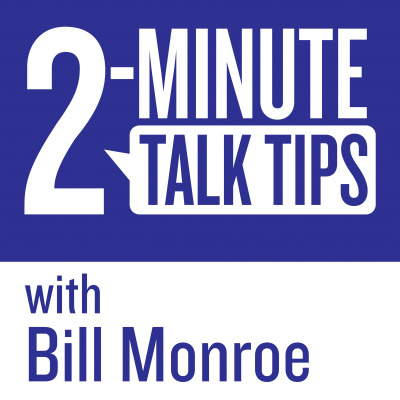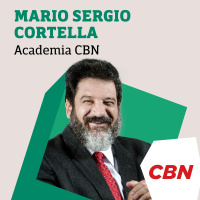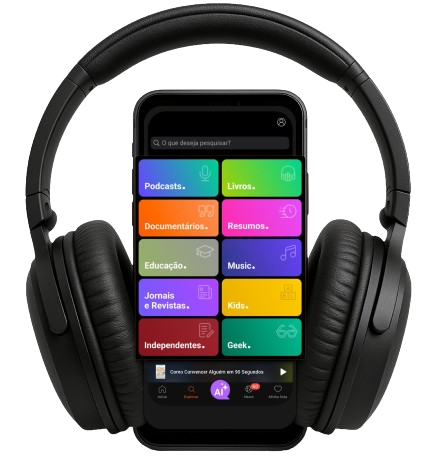Synopsis
2 Minute Talk Tips helps you improve your public speaking. Each episode starts with a 2 minute, practical tip so you get value right from that start. After that, we have a deeper discussion about issues affecting public speakers. We talk about Speaking, PowerPoint, relating to an audience, stand-up comedy, storytelling, preparation, and much more.If you've got only 2 minutes, you have time to learn stuff. If you have more time, we've got more detail.Public speaking is an important skill to have in any role that requires good communications skills. Anyone who has spent a lot of time in meetings will agree, and they will likely bemoan the lack of effective speakers. The good news is that developing strong public speaking skills isn't hard. Between books, podcasts, seminars, and meetups there are plenty of resources that can help. A lot of folks are intimidated by the idea, though. They think that to learn public speaking, they need to become the next Tony Robbins, Ronald Reagan, Dr. Martin Luther King, Jr, or Cicero. That's not true, though. Don't focus on being the best speaker ever. Instead, become a better speaker tomorrow. And do that every day. That's the pathway to success. Don't get bestget better.I'm Bill Monroe. I've built a career on public speaking and training. In my work at Microsoft and Toshiba, I used these skills to teach folks how to sell technology products and to excite them about those products. I've worked with customers in the retail, public sector, and corporate industries as a technology evangelist. Yet, while I've been conducting presentations for more than 25 years, I'm still learning and improving. I believe everyone -- from novice to expert -- can become a better speaker. Sometimes that requires small changes. Other times it requires more deliberate strategic decisions. With 2 Minute Talk Tips we can all become a little better every day.
Episodes
-
Episode 018 -- Do you Need that Animation and Speak Deliberately
25/04/2017 Duration: 14minThis Week's Tip: Do you Need that Animation? PowerPoint has lots of amazing animations and transitions. Unfortunately, many slide authors use too many of them. When a slide deck has too many animations it looks cheesy and amateurish. It can also cause problems if you want to print slides or present via a webinar. If you want to use transitions and animations in a slide deck, first ask, "Why?" or ask, "What will this animation do for me?" Think about how it will help you make your point, or think about how it will help your audience understand what you are telling them. If it doesn't contribute to your message -- if it doesn't make you more effective -- leave it out. Post Tip Discussion: Speak Deliberately Many of things we do, we do on autopilot. We walk, talk, drive, watch TV, and snack without actually thinking about it. It's like we have background computer scripts running in our brains while we focus on other things. This can be helpful for some tasks, but it's not helpful for others. A spea
-
Episode 017 -- Plan to Punt and How to Run a Panel
18/04/2017 Duration: 26minThis Week's Tip: Plan to Punt It would be great if speakers always got the amount of time they thought they would get when they arranged to speak. If they did, they could easily cover all the content in a well designed presentation. The problem is that often, the amount of time a speaker has will change at the last minute. To effectively manage your public speaking engagements, know ahead of time what to punt. Whether you lose time due to other speakers going over, the audience needing a break, or even an awesome question, you can be a more effective speaker if you know what to cut ahead of time. Have a plan so your audience doesn't see you scrambling. Remember, it's better to cut material and give the remaining material the attention it deserves than it is to burn through slides in a blur. Break Comments This week (April 17) I joined Jon Clarke on his podcast Caffeinated Comics. If you enjoy geeky and nerdy stuff, check it out. We talk about Doctor Who, Star Wars, MST3K, and more. You can learn mor
-
Episode 016 -- Count Filler Words and Raise Your Energy
11/04/2017 Duration: 13minThis Week's Tip: Count Filler Words Filler words are the ums and ahhs and likes and verys of a speech. One or two are okay, but a bunch of them will annoy an audience. We usually say them while our brain tries to catch up with our mouth. An effective speaker uses few of these since they don't help the speaker. To get rid of them, you first need to understand how many of them you use. Listen to a recording of one of your presentations and count how many times you use a filler word. Alternatively, you can ask a partner to listen to one of your live sessions while you speak, and they can count them for you. Next, divide the number of filler words by the number of minutes in your speech. This will give you the number of filler words per minute which makes it easier to compare your performance from a 10 minute presentation to a 30 minute presentation. Once you have that key metric, then you can set a goal to reduce the filler words that you use. Post Tip Discussion: Raise your Energy Level We're all
-
Episode 015 -- Face the Audience and Post-Event Reporting
04/04/2017 Duration: 19minThis Week's Tip: Face your Audience It may seem obvious that the speaker should face the audience, but we're probably all been in sessions where the speaker keeps turning away from the audience to reach and watch their slides. Each time they advance the show, they turn their back to the audience again so they can read to their audience or just figure out what point to touch on next. An audience does not usually appreciate staring at a presenter's back for 20-90 minutes. To make sure you always face your audience, do 2 things. Make sure your laptop display faces you while you speak to the audience. It shouldn't be against a wall facing the audience Know your slides well enough so that you don't need to read them to make the point you want to make. A glance should be all you need Post Tip Discussion: The Job's not Done until the Paperwork is Done The presentation doesn't end the moment the speaker leaves the stage. There is a lot of value a speaker can generate from their own post-event reporting. I
-
Episode 014 -- Manage your Handouts and 12 Webinar Tips
28/03/2017 Duration: 17minThis Week’s Tip: Manage your Handouts In many presentations, a speaker will start introducing themselves at the beginning and immediately start passing out handouts. The audience then begins reading those handouts during one of the most important parts of the presentation – the part where the speaker sets the tone for the rest of the session. Instead of doing that, pass out handouts only when they are relevant to the material. Then, you can take a moment and pause to let the audience read the material, and you can use that material to reinforce the point you are making at that moment. Post Tip Discussion: 12 Webinar Tips Webinars are a popular way to speak with large groups of people while saving time and money. They are often not quite as effective as an in-person session, but the tradeoffs are usually worth it. Here are 12 Tips to make your webinars more effective. Choose a quiet, distraction-free environment Check the background Stop streaming other stuff Know your software Streamline your sli
-
Episode 13 -- Sit in Back and The Fear of Public Speaking
21/03/2017 Duration: 21minThis week's Tip: Sit in the back of the room Before you start your presentation, and before your audience enters the room, display your most complex slide, and sit in the back row. Then sit in a few other places in the room. Your goal is to make sure you can see and read your slides from all points in the audience. You actually need to sit in the chairs to get the angles right and understand exactly what the audience sees. If your slides aren't legible, or you encounter other things that make it tough to consume and experience your presentation, you have time to fix them before you start. It's all because you literally put yourself in the place of the audience. Post Tip Discussion: It's almost cliché now for a Public Speaking tip site to repeat the claim that people are more afraid of public speaking than they are of dying. Is Public Speaking really so terrifying that people would rather die than give a speech? No. That claim comes from a frequently misquoted study from 1973. You can read more about
-
Episode 012 -- Repeat the Question and What I Saw on a Cruise
14/03/2017 Duration: 17minThis Week's Tip: Repeat the Question When an audience member asks a question during a presentation, be sure to repeat that question. There are several reasons to do this: To make sure everyone hears it To confirm the question To summarize the question To make it easier to answer When you do this, your session is more efficient since the audience won't have to ask you to repeat a question they didn't hear. Plus, people will feel acknowledged. Post Tip Discussion: What I saw on my Cruise During a week long vacation I saw 5 things that can help public speakers: Rituals Repetitive framework Own the stage Power of the stage Alternative timers Exploring these areas can help you become an even stronger speaker. Relevant Websites: JoCo Cruise Pat Rothfuss Paul and Storm Mary Robinette Kowal Wil Wheaton Molly Lewis Cards Against Humanity Call To Action Check out the JoCo Cruise website if a week at sea doing nerdy things appeals to you Leave a comment about what you've seen other presenters
-
Episode 011 -- Record Yourself and Tim Garber (Part 2)
07/03/2017 Duration: 27minThis Week's Tip: Record Yourself When you record your practice sessions or presentations, you give yourself a powerful tool for professional growth. When you're in the middle of a presentation, you have a bunch of important things to focus on. Number 1 of course is your audience. Plus you can't hear or see yourself the way your audience does. The physics of human anatomy simply make that impossible. By recording your self, you make it possible to go back later, perhaps with a little distance, and do a full assessment of your actual performance. If the recording it great, you now also have piece for your portfolio if you ever find yourself job hunting. Post Tip Discussion: An Interview with Tim Garber (Part 2) Tim Garber is a university trained public speaker passionate about health care, education, and consumer electronics. His professional speaking career began nearly 20 years ago recording retail store voicemail greetings before he moved on to teaching salespeople how to sell computers and servers
-
Episode 010 -- Parallel Structure and Tim Garber (Part 1)
28/02/2017 Duration: 16minThis Week's Tip: Use Parallel Structure Parallel Structure is a term most often associated with writing, and it's a powerful tool for a presenter who wants to land a powerful message. We see it in famous speeches from world leaders. It's embedded in the Declaration of Independence. And it's a way that any speaker can more effectively land their points. When you use parallel structure in a talk: You make it memorable You make it important You make it powerful You make it more effective. Post Tip Discussion: An Interview with Tim Garber (Part 1) Tim Garber is a university trained public speaker passionate about health care, education, and consumer electronics. His professional speaking career began nearly 20 years ago recording retail store voicemail greetings before he moved on to teaching salespeople how to sell computers and servers while teaching educators how to use tablets and projectors in the classroom. He used his vocal talents in 2010 to host “The Info Desk,” a technology podcast by the National S
-
Episode 009 -- No Eye Charts and Manage Your Q&A
21/02/2017 Duration: 11minThis Week's Tip: No Eye Charts Eye charts are presentation slides will small text, lots of numbers, and/or detailed charts. They might look okay on the presenter's desk, but to the audience, they are illegible. A presenter will often apologize for the eye chart and simple state the point they want to make. The better option is not to use illegible slides at all. If the audience can't read it, there's no value in the slide. Here are some tips to avoid them: Use only fonts larger than 24 points Include only the most relevant part of a spreadsheet Trim extra labels from charts Break up a single eye chart into multiple, legible slides Look at your slides from the back of the room while practicing so you see what the audience will see Post Tip Discussion: Managing Q&A Question and Answer is an unavoidable part of a live presentation. When you manage Q&A well, you conduct a more effective presentation. We'll talk more about handling questions in future episodes. For now, there are four key areas we
-
Episode 008 -- Avoid the G-Word and Fill Your Bag
14/02/2017 Duration: 22minThis Week's Tip: Avoid the G-Word Many speakers have picked up the bad habit of referring to a mixed-gender audience as, "You guys..." Don't do it. There's not benefit to it. You risk alienating a significant part of your audience, and you get nothing in return. Using the G-Word can only make you less effective as a speaker. Post Tip Discussion: Fill Your Bag It's important to carry all the cords and adapters you are likely to need at an event. Start by understanding what video out options you have on your laptop. The 5 most common are: VGA/RGB HDMI/microHDMI Display Port/Mini Display Port USB Wireless Display Next, try to be familiar with the ports on your destination device. You can assume that the destination device will support VGA/RGB and HDMI. It may support both. Your strategy is acquiring adapters should be to ensure that you can get from each of the video out options on your laptop to both VGA/RGB and HDMI. Once you have your adapter strategy sorted out, you can add some additional gear. A 6-12
-
Episode 007 -- Empty Your Pockets and Prepare Your Audience
07/02/2017 Duration: 16minThis Week’s Tip: Empty Your Pockets We often fill our pockets with gadgets and wallets and keys and lint. Before speaking, take all that stuff out of your pockets, and stash it in your bag, desk, best friend’s pockets or someplace else. Speaking with full pockets simply invites distractions that you don’t need. Post Tip Discussion: Prepare and Prewire Your Audience Communication is the process by which shared meaning is created. -- Practically every Communications text book I’ve ever read To maximize the effectiveness of your presentation, make sure the audience is ready to understand it. Prepare them for it by letting them know what your session will cover. This will help them focus on the topics you are discussing. When you have the opportunity to prewire the audience, do that as well. When you prewire, you meet with attendees in advance. You can brief them on the topic of your presentation, understand any questions they may have, listen to their objections, research responses, and modify your plans.
-
Episode 006 -- Beam Management and Credibility
31/01/2017 Duration: 17minThis Week's Tip: Manage your Beam If you conduct a PowerPoint slide show through a data projector, you are likely shining a beam at a screen or wall. You need to be conscious of that beam while you speak so you don't block it, stare into it, or distract your audience. It's also important to make sure nothing unintentionally casts a shadow on the screen. You can use the "B" key on your keyboard to make the display in PowerPoint go all black, or you can use the "W" to make the screen go full white, in case you want to do shadow puppets. Post Tip Discussion: Enhance your Credibility Your credibility determines how much the audience believes you. If they don't trust you, then they are unlikely to trust the information in your presentation. There are lots of ways to enhance your credibility. Here are six: Meet your goals Respect your time limits Don't tell them it was all a lie Follow up Say, "I don't know." Meet your pre-event commitments (AKA Don't forget the donuts) Call to Action: How do you increase your
-
Episode 005 -- Arriving the Day Before and a review of "Talk Like TED" by Carmine Gallo
24/01/2017 Duration: 19minThis Week's Tip: Arrive the day before the event If a speaking engagement is important enough to travel for, it's important enough to arrive the day before. There are always unexpected challenges that can arise when you have an event planned, and throwing in air travel only multiples them. When you fly in the day before you give yourself the options and flexibility you need to deal with unforeseen circumstances. Post Tip Discussion: A Review of Carmine Gallo's "Talk Like TED -- The 9 Public Speaking Secrets of the World's Top Minds" In this episode, I discuss the nature of a TED Talk, the themes in Carmine Gallo's book, and the most important take-aways that I found as I read it. (Hint: it's his secret number 8, "Paint a Mental Picture with Multisensory Experiences.") The Home for TED Talks is TED.com. You can find the 25 most viewed TED Talks here. After I recorded the episode, I did a little more research and found out the J Peterman company parodied in Seinfeld is actually a real catalog c
-
Episode 004 -- Cursor Keys and the Role of PowerPoint
17/01/2017 Duration: 13minThis Week's Tip: Use the Cursor Keys When you are in slide show mode, you can navigate a PowerPoint slide deck by using the cursor keys. This makes it easier to navigate back and forth through your slides while speaking to a group. Post Tip Discussion We start by talking about the nature of PowerPoint. Many folks have learned to fear "Death by PowerPoint," and they blame PowerPoint for bad meetings. In reality, this is not a problem with the tool. It's the way folks use PowerPoint. If you don't want to use it, that's fine, and the reality is that in most organizations and meetings, not using it is not an option. We Have Met the Enemy and He Is PowerPoint A 2004 email from Jeff Bezos explains why PowerPoint presentations aren't allowed at Amazon The trick to successfully using PowerPoint is to use it to reinforce what the speaker is saying, not to replace the speaker. In many organizations, PowerPoint is the Word Processor of choice. If your organization is like that, make sure you do not us
-
Episode 003 -- Skip the Opening Joke and Meet Jon Clarke
10/01/2017 Duration: 25minThis Week's Tip: Don't Open with a Joke Humor is tough, especially in business. Jokes need to relevant, non-offensive, and funny. If you're a nervous speakers, trying to open with a joke just makes things more challenging than they need to be. Post Tip Discussion We have an interview with Jon Clarke. Jon is a freelance writing director and copywriter with nearly 20 years of experience in the advertising industry. His portfolio includes work for Verizon, Lenovo, Jim Beam, and some of the country's leading pharmaceutical companies. On weekends he is Bono for Without U2, the popular Midwest U2 cover band As a pop culture expert, Jon has moderated panels at science fiction conventions, written a comic book, produced YouTube videos that have reached hundreds of thousands of viewers, and performed as a Stand-Up Comedian in New York. In 2013 he launched the Caffeinated Comics podcast, reporting on all the geeky activities in the Chicagoland area. Jon talks about advertising, comedy, music, and importance o
-
Episode 002 -- Use a Timer and Prepare
03/01/2017 Duration: 18minThis Week's Tip: Use a Timer Most presentations have a time limit, and exceeding that time limit is rude and ineffective. Finishing to soon can present other risks. While speaking or presenting, though, our internal clock is unreliable. Use a timer of some sort. Post Tip Discussion Preparation is the key to success in conducting a presentation. There are a lot of models for this, and I like to use this approach. Stage 1: Early Development In this stage, you determine your point, figure out what you know, identify the other resources you need to consult, learn about your audience, and confirm the logistics and timing of your presentation. Stage 2: Building Your Content Consolidate your material and make sure it still supports your goal and main point. A sample outline will include: Theme Introduction Call to Action Main Point 1 Details Examples Demos Supporting information Main Point 2 Details Examples Demos Supporting information Main Point 3, etc. Conclusion and Summary Confirm agai
-
Episode 001 -- Hydrate and a Preview of What's to Come
27/12/2016 Duration: 17minThis week's tip: Hydrate The common wisdom we encounter on the web, from well-meaning relatives, from health fans, etc., is that we should drink eight 8-ounce glasses of water a day. Or maybe not. It's become surprisingly controversial. Presenters should probably drink more. It's easy to become dehydrated while speaking, especially, if you'll be speaking for a while. Speaking and projecting means exhaling more moisture than standard conversation. It's important to replace that moisture by staying hydrated. Water: How much should you drink every day? 6 Reasons to Drink Water Water: Do You Need 8 Glasses a Day? (Infographic) Dehydration 6 Unusual Signs of Dehydration No, You Do Not Have to Drink 8 Glasses of Water a Day 12 Tips to Drink 8 Cups a Day Post Tip Discussion The Goal for the Podcast Communication skills are more important than ever, and there are a lot of aspects to that -- spelling, grammar, email etiquette, small talk, introductions, and public speaking. My goal is to help you b














